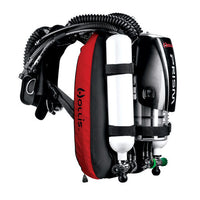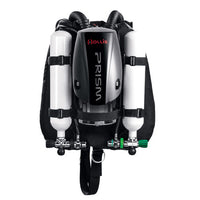Overview
The PRISM 2 is an electronically or manually controlled, constant PO2, modular, closed circuit diving system.
As open circuit (SCUBA) divers we rely upon filling our lungs with air from a pressurized gas tank with every inhalation and then exhausting that volume of air into the surrounding water with every exhalation. As we descend deeper the water pressure around us increases and the volume required to fill our lungs increases; in other words, our air supply depletes more quickly the deeper we dive.
A rebreather recycles rather than vents the exhaled breath. The exhaled breath passes into a closed loop, where it is pushed through a chemical absorbent (scrubber) to remove the carbon dioxide, and returns through the other side of the loop for the diver to re-breathe, hence the name "closed circuit rebreather" or CCR.
Breathing Loop
It’s breathing loop which is a keyed one way assembly consists of a closable mouthpiece assembly with mushroom/check valves either side, which ensure uni-directional flow.
Independent 3rd party testing has also rated the Prism 2 the lowest work of breathing of any mixed gas rebreather available today at 0.94J/L. Click here for actual test reports: ANSTI_Prism2WOB_review.pdf
Status check
With the electronics switched on, the secondary also provides a status check for the battery and displays the set point selected for the dive along with other critical information. The electronics vote between the three proprietary galvanic sensors and control the operation of a low wattage solenoid valve on the oxygen supply.
Scrubber design
A radial flow scrubber canister is mounted vertically on a backplate attached to the integrated BC, between twin supply cylinders (one each, oxygen and diluent).
Electronics
The electronics, sensors and batteries are mounted in the electronics head assembly at the top of the scrubber, with supply hoses feeding over the diver’s shoulders into the top of the counterlungs. An analog LED primary display offers a quick reference of unit performance with status and alarm indicators while an independent digital OLED secondary display verifies the unit’s performance.
Counter lungs (front or back mounted)
Dual, front or back mounted counterlungs provide the diver with a flexible reservoir equivalent to the maximum displacement of the diver’s own lung volume and ensures the lowest possible hydrostatic loading.
These counterlungs are fitted with both automatic and manual gas addition systems and a variable volume control valve (used upon ascent to vent excess expanding gas volume or to purge the loop). Diluent addition is automatically achieved as hydrostatic pressure increases and the counter lung collapses against the valve actuator.
Secondary Display (COMPUTER)
The Shearwater Petrel 3 is the computer display on the Prism 2 and was chosen for this application as it is one of the most advanced mixed gas CCR computers available today. The Petrel 3 is designed to control the Prism 2 setpoint and uses a basic decompression algorithm known as Buhlmann ZHL-16C which has been modified by the use of gradient factors.
- Depth, time and oxygen sensor display
- Bühlmann decompression model with gradient factors conservatism
- Optional VPM-B decompression model
- Imperial and metric displays
- DiveCAN communications for robust connections to rebreathers
- A menu system that adapts to diving status
- Automatic turn off after 15 minutes on the surface
- Depth sensor rated to 450 feet/140 meters of seawater
- Dive Planner
- Any combination of oxygen, nitrogen, and helium (Air, Nitrox, Trimix)
- Open and closed circuit, switchable during a dive
- 5 CC and 5 OC gases
- Gases can be changed and added during a dive
- CNS tracking
- No lockout from violating deco stops
- Automatic PPO2 set-point switching (configurable)
- Two PPO2 set-points, each of which can be set between .5 and 1.5
- Flexible user replaceable battery. Almost any ‘AA’ type
- Tilt compensated digital compass (Petrel 2 only)
- 1000 hour dive log memory
- Log downloads and firmware upgrades using Bluetooth
Primary Display (HUD)
The Primary Display (HUD) is a Shearwater DiveCAN Heads-Up Display mounted on either the right or left side of the DSV/BOV mouthpiece just below eye level. Each HUD provides a status indicator for its corresponding O2 sensor by using a “Smithers Code” flashing the status on a cycling 5-second loop during the dive.
- PPO2 display from 3 oxygen sensors.
- Modified Smither’s code blink pattern.
- Bright light emitting diodes with vibrant colors.
- Color-blind blink pattern (optional setting).
- Wet contacts for automatic turn-on.
- Option to flip orientation - can be positioned on either side of the rebreather mouthpiece.
- DiveCAN® communications interface for robust data transmission and easy upgrades, disassembly and repairs.
- Bright red end-cap LED for buddy warnings.
- Automatic brightness control optimizes viewing in all conditions.
- Red color only used for unsafe PPO2 warnings.
- Rebreather Training
- Specifications
- video
- Reviews
Rebreather Training
Every rebreather requires formal, model specific, training in order to competently dive with the equipment. Rebreather equipment pricing does not include training, and training is solely the responsibility of the purchaser. Training is available at Auckland Scuba for all models we sell. The typical full course training time is 3-7 days consisting of a classroom lecture, confined water session and at least four OW dives. Our recommendation to divers seeking rebreather training is to select an instructor having several hundred hours of rebreather dives and for whom rebreathers are their primary mode of diving.
If you are not already certified for the rebreather, per manufacturer requirements you will receive a disabled unit that can only be enabled by your instructor. Once you complete training, your instructor will permanently enable your unit.
For general information on rebreathers, transitioning to closed circuit diving, training logistics and cost estimates, plus other reference materials about rebreather training, please contact our staff senior rebreather instructor Grant Searancke.
Specifications
- Front or Back mounted counterlungs provide easy breathing with low hydrostatic loading
- Lowest Work of Breathing in industry at 0.94 J/L - Tested at 100M by ANSTI
- Unit weight when fully charged, in standard
configuration - approx. 47lbs - 3.5 Liter split counterlungs allows inhale and exhale counterlungs for high work loads
- Counterlung drains make it easy to remove water during a dive
- All gas lines external to the breathing loop prevents leaks from affecting the PPO2
- Automatic diluent addition valve adds diluent during descent or when the loop volume is low
- Manual diluent addition valve adds on board or off board diluent for loop flushing
- Gases - Air, Trimix, and Heliox
- Manual oxygen addition valve allows for manually controlling oxygen PPO2
- High performance open circuit Bail Out Valve option
- Integral harness and BC or
Backplate standard makes the Prism 2 ready to dive out of the box - Full range of wings/harness gives the ultimate customization
- Accepts 13, 19, or 30 cu.ft. cylinders for flexible gas management
- Eye level LED Primary display provides easy to monitor system status
- Displays PPO2 for each oxygen sensor is used to control PPO2 manually & assure electronics system is nominal
- External power switch is easy to power on
- Easy calibration with a push button O2 calibration
- Large OLED Secondary Display is easy to read, even for your buddy
- PPO2 Monitoring of Three Sensors Continuous display of each sensor’s PPO2, mv reading easy to access
- Closed Circuit & Open Circuit, 5 gases supports diluent switching & Multi-gas mix dive plans
- 2 button push OC bailout - If you have to leave the loop, quickly switches to bailout support
- CNS Tracking based on real time
oxygen exposure - Software Update via web
- Dive Log download and software updates via Bluetooth









